Class 8 Science - Question Answers Crop Production and Management- 1
Q.1. Define crop along with examples
Ans. Plants of same kind that are grown and cultivated at one place on large scale are called a crop. Some of the crop plants are wheat, rice, maize, sugarcane, cotton, vegetables, fruits etc.
 Examples of CropsQ.2. Differentiate between kharif and rabi crops
Examples of CropsQ.2. Differentiate between kharif and rabi crops
Ans.
 Kharif vs RabiQ.3. What do you mean by preparation of soil?
Kharif vs RabiQ.3. What do you mean by preparation of soil?
Ans. Preparation of soil is a very important step in agriculture before cultivation of crops. It includes loosening of soil, removing weeds from the soil and leveling of soil before sowing of seeds. Loosening of soil improves the air circulation in soil and enhances the water retaining capacity of the soil.
Q.4. Why loosened soil is important for cultivation of crops?
Ans. It is necessary to turn and loosen the soil because only loose soil allows the roots to penetrate freely deeper into soil. The roots can breathe easily in loose soil. The deep roots hold the plants more firmly. The water also can reach easily up to more depth in loose soils. Microbes and worms can also grow in loose soil.
Q.5. Write a paragraph in your own word on each of the following:
(a) Tilling
(b) Weeds
Ans.
(a) Tilling: The process of loosening and turning of the soil is called tilling or ploughing and is carried on by using a plough. Ploughs are made by wood or iron material, it is being used since ancient time for different purposes like tilling the soil, adding fertilisers to crops, removing weeds etc. this implement is drawn by a pair of bulls or other animals like camels, horses etc.
(b) Weeds: Weeds are unwanted plants that grow along with crop plants and compete with them for water, nutrients, space and light, thus they affect growth of crop plants. Some of the weeds are poisonous for animals and human beings and they interfere even in harvesting of crop plants and the removal of weeds is called weeding.
Q.6. Write shorts notes on:
(a) Sowing of seeds
(b) Threshing
Ans.
(a) Sowing of seeds: One of the important part of crop production is sowing. Good quality seeds are selected and are sown in prepared soil with the help of various tools like traditional tools and seed drill.
(i) Traditional tools: The shape of this tool is like a funnel which is filled by seeds, then the seeds are passed down through two or three pipes having sharp ends and these ends pierce into the soil and place seeds there.
 Sowing
Sowing
(ii) Seed drill: This tool is used for sowing with the help of tractors and it sows the seeds uniformly and at proper distances and depth, it also ensures covering of the seeds from soil after sowing, so that seeds could not get damaged by birds and by other organisms. Sowing by using a seed drill saves time and labour. In order to avoid overcrowding of plants it is very important to leave some space between two seeds. This also allows plants to get sufficient sunlight, nutrients and water from the soil.
 Seed Drill
Seed Drill
(b) Threshing: Threshing is the process of separating the grains from the straw and chaff. This is carried out with the help of a machine called combine which works as harvester and thresher both.
Q.7. What are the advantages of a cultivator over plough for the purpose of ploughing?
Ans. Ploughing by cultivators save time and labour as cultivator is driven by tractors whereas plough is driven by pair of bull.
Q.8. How could you separate good and healthy seeds from the damaged ones?
Ans. Take a beaker half filled with water and put some seeds into it and stir well, wait for some time. You will observe some seeds sink in water while some seeds float in water, damaged seeds become hollow and lighter and thus they float on water.
Q.9. Write a short notes on tools used for sowing seeds.
Ans. Tools used for sowing of seeds are:
(a) Traditional tools: The shape of this tool is like a funnel which is filled by seeds, then the seeds are passed down through two or three pipes having sharp ends and these ends pierce into the soil and place seeds there.
(b) Seed drill: This tool is used for sowing with the help of tractors and it sows the seeds uniformly and at proper distances and depth, it also ensures covering of the seeds from soil after sowing, so that seeds could not get damaged by birds and by other organisms. Sowing by using a seed drill saves time and labour. In order to avoid overcrowding of plants it is very important to leave some space between two seeds. This also allows plants to get sufficient sunlight, nutrients and water from the soil.
Q.10. What are the advantages of a seed drill used for sowing?
Ans. Advantages of seed drill are as follows:
(a) This sows the seeds uniformly at equal distance and depth.
(b) It ensures that seeds get covered by the soil after sowing.
(c) This protects seeds from being eaten by birds.
(d) Sowing by using a seed drill saves time and labour.
Q.11. How could we supply nutrients to the soil?
Ans. We can supply nutrients to the soil by adding manure and fertilisers. Manures are organic substances obtained from the decomposition of plants and animal wastes which provides lot of humus to the soil. It is very important for the healthy growth of plants, and Fertilisers are chemical substances which are rich in particular nutrients like nitrogen, phosphorus and potassium, they are produced in factories. Examples: Urea, NPK, Ammonium sulphate etc.
Q.12. Differentiate between manure and fertilizers.
Ans.
 Manure vs Fertilizers
Manure vs Fertilizers
Q.13. What do you understand by manuring and what are the harmful effects of improper or insufficient manuring?
Ans. Farmers add manure to the fields to replenish the soil with nutrients and to increase their crop production, this process of adding manures to the field is called manuring. Improper manuring results in poor development of crop plants and unhealthy crops.
Q.14. How could we prepare organic manure?
Ans. Organic manure can be prepared in fields. Dump plant and animal wastes in pits at open places and allow it to decompose by some of the microorganisms; the decomposed matter is used as manure.
Q.15. What are the harmful effects of fertilisers?
Ans. Harmful effects of fertilisers are as follows:
(a) The excessive use of fertilisers makes soil less fertile.
(b) It is also considered as one of the source of water pollution
 Fertilizers
Fertilizers
Q.16. What is crop rotation? How it helps in replenishment of the soil?
Ans. Crop rotation involves growing two or more crops alternatively on the same piece of land. For example,after growing wheat for a season, farmers prefer to grow crop of legume family such as peas,gram and groundnut. These leguminous plants have nitrogen fixing bacteria on their root nodules. These bacteria convert atmospheric nitrogen into compound that can be used by plants. This makes the soil rich in nitrogen which is good for crops.
Q.17. State advantages of manure
Ans. Advantages of manure:
(a) Water holding capacity of soil is increased by adding manure to the soil
(b) It increases the total number of friendly microbes in soil and thus increases soil fertility
(c) By adding manure soil become more porous so that the exchange of gases becomes easy
(d) It improves the texture of the soil.
Q.18. What is irrigation and its importance?
Ans. Irrigation is the process of applying water to the crops artificially to fulfil their water requirements. The various sources of water for irrigation are wells, ponds, lakes, canals, tube wells, and even dams. Water is very important for the proper growth and development of flowers, fruits and seeds of plants, it plays an important role in
(a) Germination of seeds
(b) Transportation of nutrients in different parts of plants
(c) Protects crops from both frost and hot air currents
(d) It maintains the moisture of the soil
Q.19. Why should we supply more water to crops during summer?
Ans. Because of the increased water evaporation rate from the soil and the leaves, it is important to increase the frequency of watering in summer.
Q.20. Explain modern methods of irrigation.
Ans. Modern method of irrigation help us to use water economically, it involves following methods:
Sprinkler system: In this system the perpendicular pipes with rotating nozzles on top are joined to the main pipeline at regular intervals when water is allowed to flow through the main pipe under pressure with the help of pump, it escape from the rotating nozzles, it gets sprinkled on the crop as if it is raining, sprinkler is very useful for sandy soil.
 Sprinkler system
Sprinkler system
Drip system: In this system, water falls drop by drop just at the position of the roots. So it is called a drip system. It is the best technique for watering plants, trees and gardens. This system provides water to plants drop by drop, and water is not wasted at all.
Q.21. List various agricultural practices.
Ans. The agricultural practices are listed below:
(a) Preparation of soil
(b) Sowing
(c) Adding manure and fertilizers
(d) Irrigation
(e) Protecting from weeds
(f) Harvesting
(g) Storage
Q.22. What is plough?
Ans. This implement is made of wood and iron. It is drawn by a pair of bulls or other animals. It contains a strong triangular iron strip called ploughshare. The main part of the plough is a long log of wood which is called ploughshaft. The plough is used for tilling the soil, adding fertilizers to the crop, removing the weeds and scraping of soil.
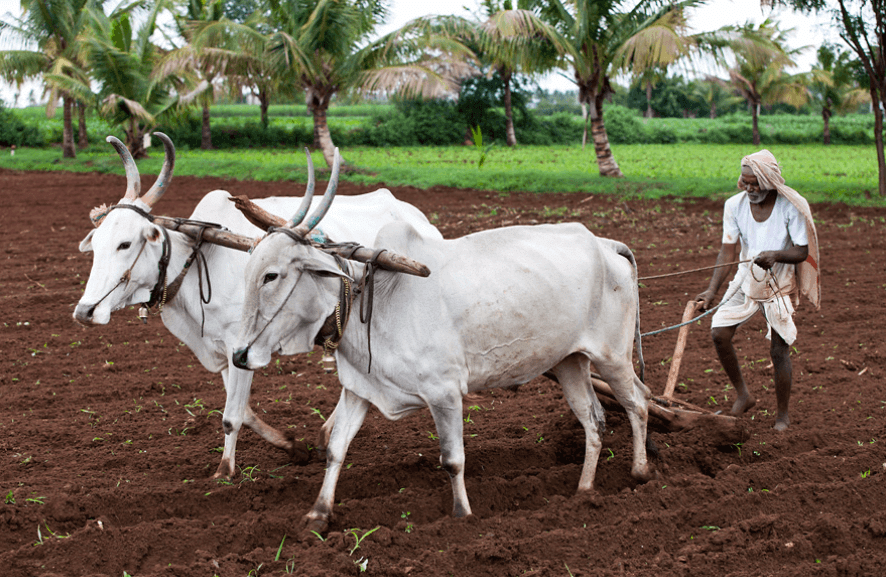 Farmer Ploughing
Farmer Ploughing
Q.23. What is hoe? What is its use?
Ans. Hoe is a simple tool which is used for removing weeds and for loosening the soil. It has a long rod of wood or the iron. A strong broad and bent plate of iron is fixed to one of its ends and works like a blade. It is also pulled by animals.
Q.24. Explain the preparation of manure by the farmers.
Ans. Manure is an organic substance obtained from decomposition of plant or animal wastes. Farmers dump plant and animal wastes in pits at open places and allow it to decompose. The decomposition is caused by some microorganisms. The decomposed matter is used as organic manure.
Q.25. What are fertilizers? How do they differ from manure on the basis of their formation?
Ans. Fertilizers are the chemical substances which are rich in a particular nutrient. Fertilizers are produced in the factories while manure can be made by farmers themselves in the fields. Some fertilizers are urea, ammonium sulphate, super‑phosphate, potash, N.P.K. (Nitrogen, Phosphorus, Potassium). Fertilizers are used to get better yield of crops.
Q.26. What is the role of water in the production of crops?
Ans. Water is essential for plants. It helps in the germination of seeds because seeds cannot germinate under dry conditions. Nutrients dissolved in water get transported to each part of the plant. It protects the crop from frost and hot air currents. Water is important for proper growth and development of flowers, fruits and seeds of plants. Along with water minerals and fertilizers are also absorbed. Plants contain nearly 90% water. The time and frequency of irrigation varies from crop to crop, soil to soil and season to season.
Q.27. Explain traditional methods of irrigation.
Ans. The water available in wells, lakes and canals is lifted up by different methods in different regions, for taking it to the fields. Cattle or human labour is used in these methods. These methods are cheaper but less efficient. The various traditional ways are:
(a) Moat (Pulley system)
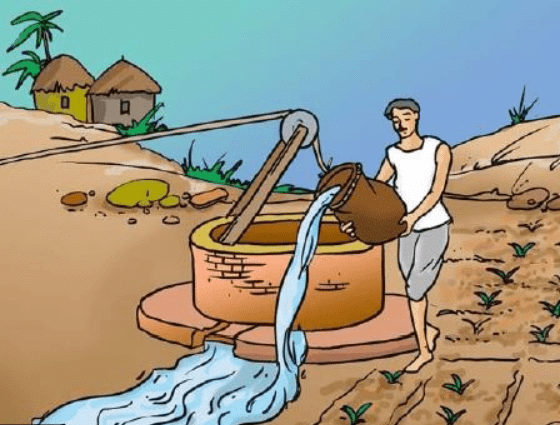 Moat
Moat
(b) Chain pump
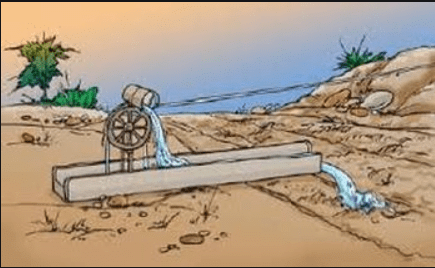 Chain Pump
Chain Pump
(c) Dhekli
 Dhekli
Dhekli
(d) Rahat (Lever system)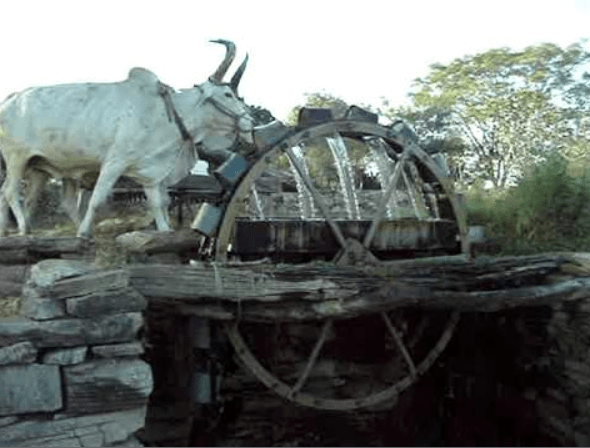 Rahat
Rahat
Q.28. What is weeding? Why is it necessary?
Ans. The process of removal of weeds is called weeding. Weeding is necessary since weeds compete with crop plants for water, nutrients, space and sunlight. Thus they affect the growth of crop. Some weeds interfere even in harvesting and may be poisonous for animals and human beings.
Q.29. Explain the various methods of weeding.
Ans. Farmers use many ways to remove weeds and control their growth. Tilling before sowing of crops helps in uprooting and killing weeds, which may then dry up and get mixed with the soil. The best time for the removal of weeds is before they produce flowers and seeds. The khurpi is used to remove weeds by uprooting or cutting them from time to time. A seed drill is also used to uproot weeds. Weeds are also controlled by using weedicides like 2, 4‑D.
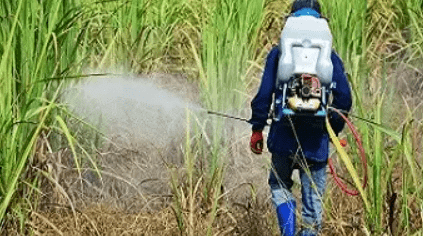 Spraying Weedicide
Spraying Weedicide
Q.30. Explain various methods of harvesting in our country.
Ans. There are mainly two methods which are used to harvest the mature crops:
(a) Manual: A device called sickle is used to harvest mature crops manually.
(b) By Machine: A machine called harvester is also used to harvest crops. A machine called combine which is in fact, a combined harvester and thresher. This machine does both the functions of harvesting and threshing at the same time.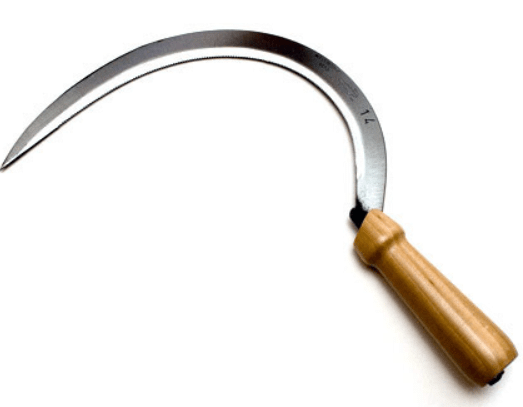 Sickle
Sickle
 Combine
Combine
Q.31. What do you know about Harvest Festival?
Ans. After three or four months of hard work there comes the day of harvest. The sight of golden fields of standing crops, laden with grains fills the hearts of farmers with joy and a sense of well being. Men and women celebrate this period with great enthusiasm. This period of joy is called Harvest Festival. Pongal, Baishakhi, Holi, Diwali, Nabanya and Bihu are such Harvest Festivals.
Q.32. How do the grains stored and preserved?
Ans. Farmers store the grains in jute bags or metallic bins. However, large scale storage of grains is done in silos and granaries, to protect them from pests like rats and insects. Dried neem leaves are used for storing food grains at home. For storing large quantities of grains in big godowns, specific chemical treatments are required to protect them from pests and microorganisms.
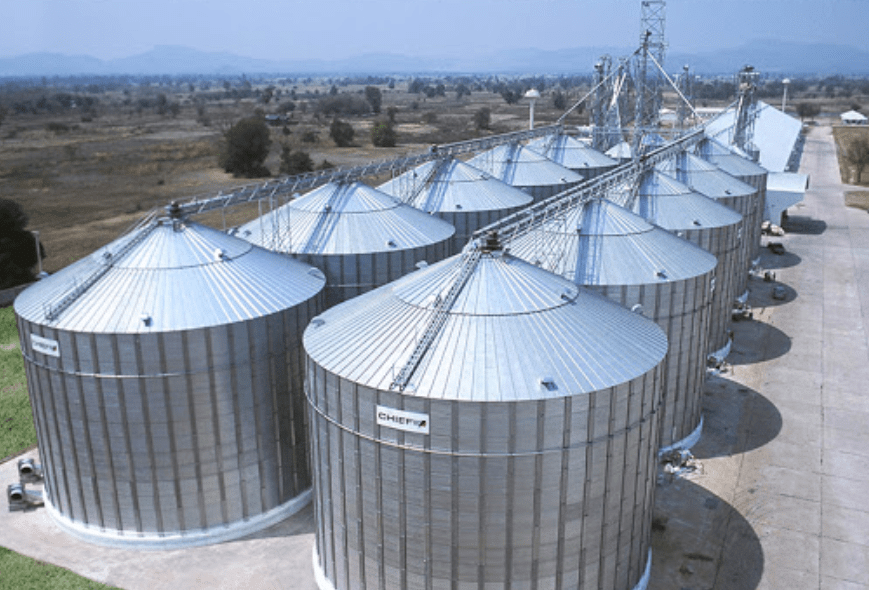 Silos for storage of grains
Silos for storage of grains
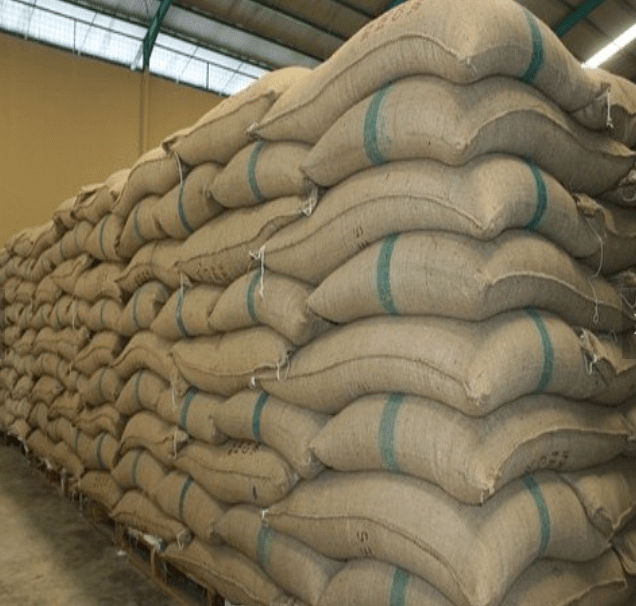 Storage of grains in granaries
Storage of grains in granaries
|
91 videos|273 docs|44 tests
|
FAQs on Class 8 Science - Question Answers Crop Production and Management- 1
| 1. How is crop production and management important for agriculture? |  |
| 2. What are the different methods of irrigation used in crop production? |  |
| 3. How can farmers control pests and diseases in crop production? |  |
| 4. What are the benefits of crop rotation in crop production and management? |  |
| 5. How can farmers improve soil fertility in crop production? |  |

|
Explore Courses for Class 8 exam
|

|













